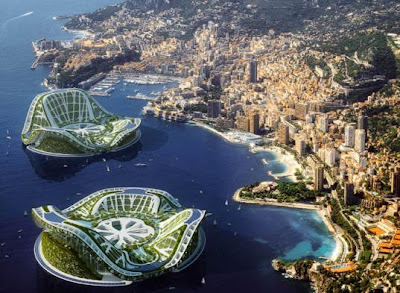Wow – this one has exploded in the past few weeks. I refer you to LilyPads by Vincent Callebaut Architectures. I was planning on including it in the last version of Veg.itecture #30 – but it seems as if this needs some of it’s own space to breathe. This project has been everywhere, and has stirred up emotions and controversy. You can read about the project in more depth at a variety of sources, so I’m going to, per usual, go to the imagery.
The project is envisioned for the year 2100, and is subtitled ‘A Floating Ecopolis for Climate Refugees’, which is definitely a present and realistic danger.
And a brief synopsis (via Callebaut’s site): “It is a true amphibian half aquatic and half terrestrial city, able to accommodate 50,000 inhabitants and inviting the biodiversity to develop its fauna and flora around a central lagoon of soft water collecting and purifying the rain waters. This artificial lagoon is entirely immersed ballasting thus the city. It enables to live in the heart of the subaquatic depths. The multifunctional programming is based on three marinas and three mountains dedicated respectively to the work, the shops and the entertainments. The whole set is covered by a stratum of planted housing in suspended gardens and crossed by a network of streets and alleyways with organic outline. The goal is to create a harmonious coexistence of the couple Human / Nature and to explore new modes of living the sea by building with fluidity collective spaces in proximity, overwhelming spaces of social inclusion suitable to the meeting of all the inhabitants – denizen or foreign-born, recent or old, young or aged people.”

A close up of the vegetated walls and wind generation turbines, or what I like to call ‘The Seagull Blender’ – I would steer cleer of the vents on those guys. 
It’s definitely a large scale version of Biomimicry – as Mad Architect points out: “Inspired by the lilypad of Amazonia Victoria Regia, this floating ecopolis will be made of polyester fibres and covered by a layer of titanium dioxide (TiO2). The Lilypad City will made use of all renewable energies – solar, thermal and photovoltaic energies, wind energy, hydraulic, tidal power station, osmotic energies, phytopurification, biomass will produce much more energy than it consumes and also, the floating structure will “reach” zero carbon emissions as all the carbon-dioxide and the waste will be recycled.”
:: Amazonia Victoria Regia (surface, bottom) – image via Archinect
While I jest with my title, it’s definitely a laudable idea and something worthy of investigations (not to mention a cool vision with some great science and design to back it up). In essence, it’s potentially necessary and completely plausible. A few questions, I’m sure others have kicking around (or have discussed). First, will our world possess enough foresight to build this very cool structures in time for the inevitable flooding caused by global warming? My big question is: Who get’s on board? Is it the ones with the means to pay for the luxury, or is it real climate refugees in poor countries, with little fare to offer? And if there are enough of these for all – do they get segregated, or are they a real floating ecopolis utopia, where everyone lives in harmony because they are glad they survived…? While climate refugees could span economic classes – the amount of cash and amenity (as well as the 50,000 population limit) makes this an option I will guess will not be available to all.

:: image via The Design Blog
So I mentioned controversy, right? Archinect featured the project in it’s showcase in mid-June – then promptly pulled the plug due to similarities to another project… in their words: “It had come to our attention that this featured project is surprisingly similar to an earlier scheme by PLOT/JDS architects title Mermaid… We’re going to keep the feature offline while we explore this issue further, but feel free to review both projects, as they’re both quite inspiring.”
This thread was picked up by Architecture.MNP, which discussed the fact that ‘Lily Pads Aren’t Snowflakes…’ by looking at some of the similarities between Lily Pads and the Dolphinarim and Wellness Center . PLOT – btw, was a collaboration between two firms subsequently, Julien de Smedt Architects (JDS) and Bjarke Ingels Group (BIG) – with this project continuing on in both names as I’ve seen posted. Plus, it’s worth a look at the Mermaid-cliented project – where it’s populated by beautiful and scantily clad – I assume, mermaids?

While there are definite similarities, there is also a LOT of copycatting going on in design. The comment stream on Archinect showed a great example… again – between the top image – Glen Small designed Turf Town in Los Angeles (1983) and the bottom – BIG/PLOT designed Mountain Dwellings in Copenhagen (2006). This won’t be the first nor last time this happens:


Similarites in design… never 












